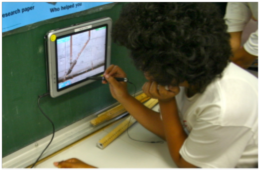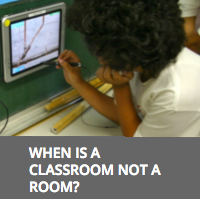Based on a submission by Thomas Moher about his NSF-funded project to use embedded phenomena to engage learners in scientific practices.

in the WallCology embedded phenomenon
Researchers from the University of Illinois at Chicago have designed a method for turning elementary school classrooms into imaginary places—subduction zones, planetary systems, small towns sitting atop aquifers, or ecological habitats—that become the object of collective scientific investigation. Dynamic phenomena are imagined to be “embedded” in the physical space of the classroom, made accessible through stationary or mobile “portals” (tablet and laptop computers, large displays, etc.) that provide continuous location-specific visualization of the phenomenon. Over weeks, students collectively observe, manipulate, and chronicle the embedded phenomenon, and constructing models to reflect their understandings.
NSF Project Information
Title: EXP: Using Technologies to Engage Learners in the Scientific Practices of Investigating Rich Behavioral and Ecological Questions
PIs: Thomas Moher, Tanya Berger-Wolf, Leilah Lyons, Joel Brown, Brian Reiser
Award Details
Embedded phenomena instructional units engage young learners in the kind of collective, patient science practices that involve careful and collaborative data collection, analysis, and interpretation over an extended period of time. While advocated within modern pedagogies and science education standards, these remain rare experiences in elementary classrooms. By situating learning within social role-play in a responsive, immersive public environment, affording opportunity for physical activity, and engaging whole classes simultaneously, embedded phenomena provide strong motivation for productive engagement in science practices.
In a collaboration with researchers at the University of Toronto, embedded phenomena technologies are complemented with software tools that allow students to create, share, and use one another’s contributions to an electronic community knowledge base. In another collaboration, the project is working with National Geographic to make a seismology embedded phenomenon, RoomQuake, available as a public web-based resource.
Image Credit: Brenda López Silva, University of Illinois at Chicago

